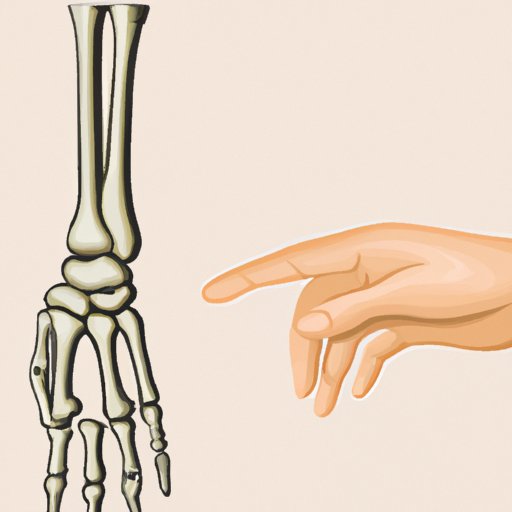Introduction: The Importance of Knowing Your Hand’s Bones
From writing and typing to gripping and holding, the hand is an essential part of our daily lives. Despite its importance, most people don’t give much thought to the intricate anatomy that makes the hand function. Understanding how many bones are in the hand and where they’re located can help us better appreciate and care for this vital appendage.
In this article, we’ll explore the fascinating anatomy of the hand, including the 27 bones that make up this essential appendage. We’ll delve into the different bones in the hand, their functions, and how they work together to give us the dexterity and mobility we need to go about our daily routines.
The Fascinating Anatomy of the Hand: How Many Bones Make Up This Important Appendage?
Bones are the structural building blocks of our bodies, providing support, protection, and mobility. In the hand, there are 27 bones, which work together to give us the ability to pick up, grip, and manipulate objects with precision.
These 27 bones are divided into three groups:
- 8 carpal bones in the wrist
- 5 metacarpal bones in the palm
- 14 phalanges in the fingers
From Fingers to Wrist: A Comprehensive Guide to the Bones of the Hand
Each section of the hand plays a crucial role in its function, and the bones that make up these sections are equally important. Here’s a closer look at each section:
The Fingers
The fingers consist of 14 phalanges, with three phalanges in each finger and two in the thumb. These bones are arranged in a way that allows us to flex and extend each digit, giving us the precision we need to perform tasks such as typing, writing, and playing musical instruments.
The Palm
The palm contains the metacarpal bones, which run from the wrist to the base of each finger. These bones are long, thin, and cylindrical, and provide support for the hand while also allowing us to grip objects with force.
The Wrist
The wrist consists of eight carpal bones, which are small and irregularly shaped. These bones form a complex system that allows the hand to move in all directions, from side to side and up and down.
The Surprising Number of Bones in Your Hand and Why Each One Counts
While each bone in the hand may seem small and insignificant on its own, together, they form a complex system that allows for incredible dexterity and mobility. When one bone becomes injured or damaged, it can have a significant impact on the hand’s overall function, making it important to understand each bone’s role.
For example, the metacarpal bones provide strength and support, while the phalanges give us the ability to grip and manipulate objects with precision.
Injuries to any of these bones can result in reduced range of motion, pain, and in severe cases, permanent disability.
Hand Bone Breakdown: Understanding the 27 Bones and Their Functions
Here’s a comprehensive breakdown of each bone in the hand and its function:
The Carpal Bones
- Scaphoid: Helps to distribute weight from the wrist to the thumb and fingers
- Lunate: Provides stability to the wrist joint and allows for wrist flexion and extension
- Triquetral: Helps to stabilize the wrist joint and is essential for gripping and twisting motions
- Pisiform: Provides an attachment point for the muscles in the hand and wrist
- Trapezium: Allows for thumb opposition, which is essential for grasping and holding objects
- Trapezoid: Helps to distribute weight from the hand to the wrist
- Capitate: Provides the wrist joint with stability and allows for wrist rotation
- Hamate: Has a hook-like process that provides an attachment point for the muscles in the hand
The Metacarpal Bones
The five metacarpal bones are numbered one to five, starting with the thumb. They provide support for the hand while also allowing us to grip and manipulate objects with force.
The Phalanges
The 14 phalanges are broken down into three groups:
- Distal phalanges: The bones at the end of each finger, responsible for the finger’s movement and sensitivity
- Intermediate phalanges: The bones between the distal and proximal phalanges, which help to stabilize the finger and allow for more precise movements
- Proximal phalanges: The bones at the base of each finger, which allow the fingers to bend and flex
The Handiest Bone Guide You’ll Ever Need: A Visual Tour of the Bones in Your Hand
If you want to take a more in-depth look at the bones in your hand, there are several resources available to help you learn more. One way to visualize the bones in your hand is to look at diagrams or images.
There are different types of bones in the hand, including long, short, flat, and irregular bones, and each type plays a different role in the hand’s function.
Conclusion: Understanding Your Hand for Better Health and Function
The hand is a complex and intricate appendage that plays a crucial role in our daily lives. Understanding how many bones are in the hand and how they work together can help us appreciate the incredible capabilities of this essential body part.
By taking the time to learn about the different bones in our hands, we can better understand the importance of hand health and function and take steps to prevent injury or damage that could impact our quality of life.
